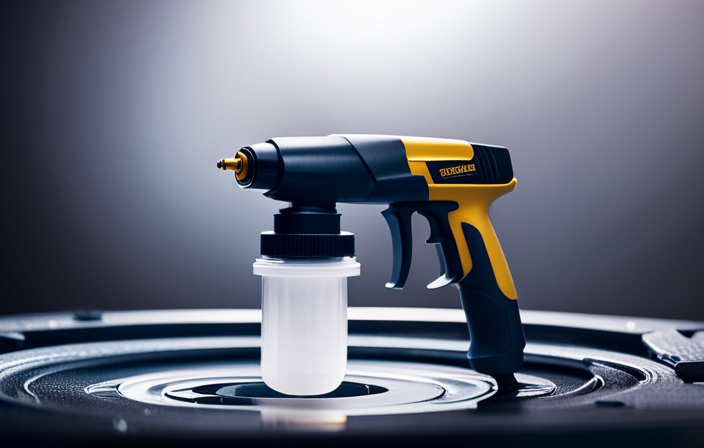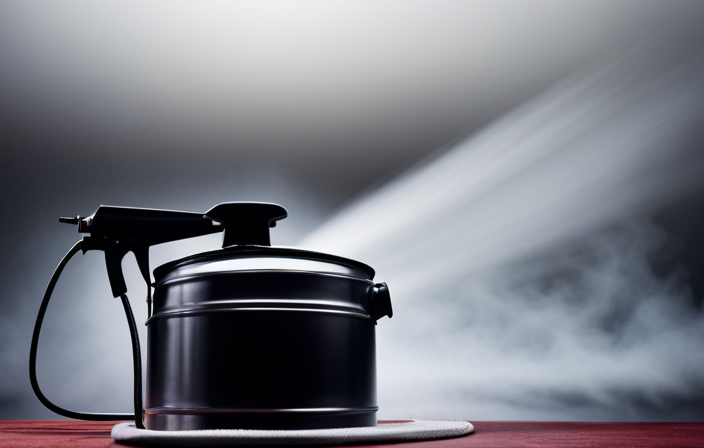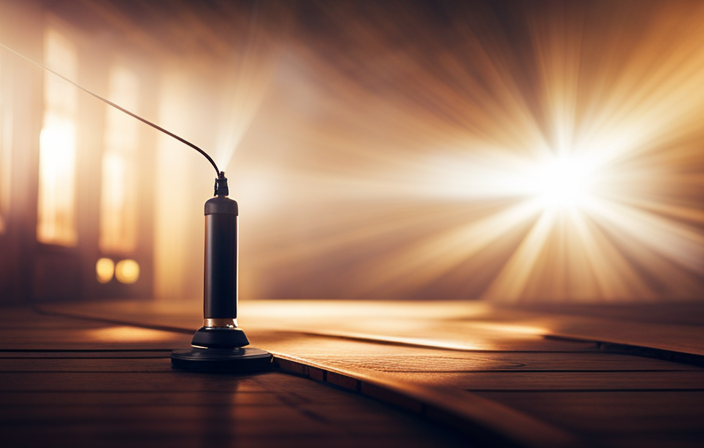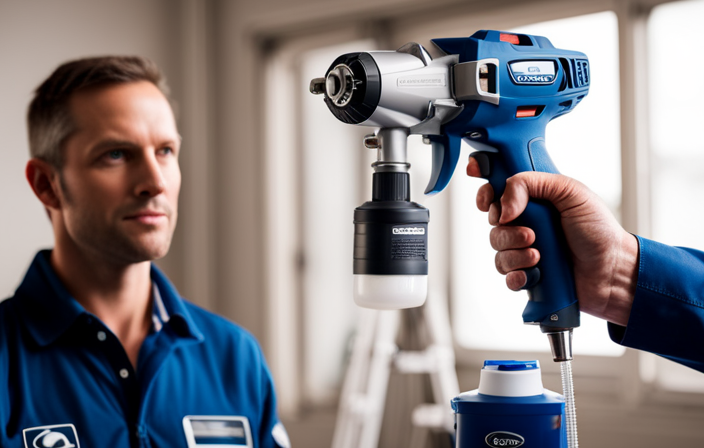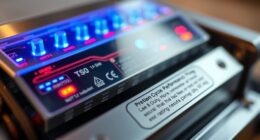Did you know that regularly cleaning your airless paint sprayer after each use can extend its lifespan and ensure top performance? It’s true! By taking the time to properly clean your sprayer, you’re not only maintaining its functionality but also preventing clogs and buildup that can affect the quality of your painting projects.
In this article, I will guide you through the step-by-step process of cleaning your airless paint sprayer when you’re done using it. Here’s what you need to do:
-
Gather your supplies:
- Clean water or a cleaning solution recommended by the manufacturer
- Cleaning brushes or small tools
- Empty containers for collecting waste material
- Protective gloves and goggles
-
Flush the system with water or a cleaning solution:
- Start by removing the paint canister and emptying any remaining paint.
- Fill the canister with clean water or the recommended cleaning solution.
- Connect the sprayer to a water source or container filled with the cleaning solution.
- Turn on the sprayer and flush the system by spraying the liquid through the nozzle until it runs clear.
-
Clean the filters, nozzles, pump, and pressure control knob:
- Remove the filters and clean them thoroughly using water or the cleaning solution.
- Use a brush or small tool to remove any clogs or build-up from the nozzles.
- Wipe down the pump and pressure control knob with a damp cloth.
-
Check for any clogs or build-up:
- Inspect the hose, gun, and other components for any clogs or build-up.
- If you find any, use a brush or small tool to remove the debris.
-
Rinse and dry all the components:
- Rinse all the components that came into contact with the cleaning solution or water.
- Allow them to air dry completely before reassembling the sprayer.
By following these thorough instructions, you’ll be able to store your cleaned sprayer properly for future use and ensure that it continues to deliver professional-quality results every time. Remember, regular cleaning and maintenance are key to keeping your airless paint sprayer in top shape!
Key Takeaways
- Regularly clean and inspect the spray gun, nozzle, and suction tube for clogs or build-up
- Rinse and dry all components thoroughly after each use to prevent residue and blockages
- Store the sprayer in a cool, dry, and upright position, and cover it to protect from dust and debris
- Proper maintenance and cleaning will extend the lifespan and ensure optimal performance of the sprayer.
Gather Your Supplies
Now that you’re finished painting, it’s time to gather up all your supplies for cleaning your airless paint sprayer.
Cleaning an airless paint sprayer is crucial for its longevity and optimal performance. To ensure a smooth cleaning process, here are a few cleaning tips and maintenance recommendations.
First, gather a bucket of warm water, a cleaning solution specifically designed for paint sprayers, a cleaning brush, and some clean rags or towels. It’s essential to have all these supplies ready before starting the cleaning process. By having everything prepared, you’ll be able to clean your sprayer efficiently and effectively.
Now, let’s move on to the next step and prepare the sprayer for cleaning.
Prepare the Sprayer for Cleaning
To prepare the sprayer for cleaning, follow these steps:
-
Ensure that you have completed all necessary steps to prepare the tool for maintenance after use.
-
Gather the following supplies:
- A cleaning solution: Choose a water-based cleaner or mineral spirits, following the manufacturer’s recommendations.
- Cleaning brushes: These will help remove paint residue and clogs from the sprayer’s components.
- Safety gloves and goggles: Protect yourself from splashes and fumes.
- A clean cloth: Use it to wipe down the sprayer’s exterior and remove excess paint.
- A bucket or container: This will hold the cleaning solution during the process.
By using these supplies and following the proper cleaning procedures, you can prevent clogs and build-up in your airless paint sprayer.
Now, let’s move on to the next section about emptying and cleaning the paint container.
Empty and Clean the Paint Container
To start, grab the container and pour out the remaining paint in a well-ventilated area or outside. Make sure to empty it completely.
Once the container is empty, it’s time to clean it thoroughly. Use a clean cloth or paper towel to wipe away any excess paint from the inside. If there are any stubborn spots, use a brush to scrub them off.
For proper cleaning, it’s recommended to use warm soapy water or a cleaning solution specifically designed for airless paint sprayers. Gently scrub the container with the cleaning solution and rinse it with clean water until all traces of paint are gone.
By following these cleaning tips and maintenance techniques, you can keep your airless paint sprayer in top-notch condition.
Now, let’s move on to the next section and learn how to flush the system with water or cleaning solution.
Flush the System with Water or Cleaning Solution
Once you’ve conquered the task of emptying and cleaning the paint container, it’s time to take your airless paint sprayer to the next level by flushing the system with water or a specialized cleaning solution. This step is crucial to ensure the longevity and optimal performance of your sprayer. Here are some best practices for cleaning your airless paint sprayer:
-
Begin by filling the paint container with water or a cleaning solution, depending on your preference and the type of paint used.
-
Connect the sprayer to a water source and turn it on, allowing the water or solution to flow through the system.
-
Spray the liquid onto a waste material, such as a piece of cardboard, until it runs clear without any traces of paint.
-
Repeat the process if necessary, especially if you were using heavy or stubborn paint.
By following these steps, you will effectively remove any residual paint and prevent clogging in the system. Once you have completed this process, it’s time to move on to the next section and clean the filters and nozzles, ensuring an even better performance for your airless paint sprayer.
Clean the Filters and Nozzles
Now it’s time to tackle the important task of giving your filters and nozzles a thorough cleaning, ensuring peak performance for your trusty paint-spraying companion. Proper cleaning maintenance of the filters and nozzles is crucial to prevent clogs and maintain consistent spray patterns. To clean the filters, start by removing them from the sprayer and rinsing them with water or a cleaning solution. Use a soft brush or toothbrush to gently scrub away any paint residue. For the nozzles, soak them in a cleaning solution for a few minutes, then use a small brush or needle to remove any stubborn paint particles. Once clean, rinse both the filters and nozzles with water and allow them to dry before reassembling. Remember, regular cleaning and maintenance are troubleshooting tips that can help prolong the life of your airless paint sprayer. Now, let’s move on to the next step: removing and cleaning the spray gun.
Remove and Clean the Spray Gun
Get ready to experience the satisfaction of a perfectly clean and well-maintained spray gun that will make your painting projects a breeze! To clean the spray gun, start by disassembling it according to the manufacturer’s instructions. This will allow you to access all the components for a thorough cleaning.
Here are some troubleshooting tips to keep in mind while cleaning:
- Inspect the needle and nozzle for any clogs or debris.
- Check the air cap for any signs of damage or wear.
- Clean the fluid passages with a suitable cleaning solution.
- Use a brush or toothpick to remove any dried paint from the gun.
- Lubricate the moving parts with a spray gun lubricant.
By following these steps, you can ensure that your spray gun is in top-notch condition for your next painting project. Now, let’s move on to the next section and learn how to clean the pump and pressure control knob.
Clean the Pump and Pressure Control Knob
Ensure that your pump and pressure control knob are spotless, allowing you to effortlessly achieve the perfect paint application and experience a sense of pride in your work. To clean the pump, start by disconnecting the hose and flushing it with clean water to remove any paint residue. Next, remove the pressure relief valve and clean it thoroughly to ensure proper functioning. Use a brush or cloth to remove any debris or build-up from the valve. Once the pump and pressure control knob are clean, you can move on to the next step of checking for any clogs or build-up in the system. By following these steps, you can maintain the performance and longevity of your airless paint sprayer.
Check for any Clogs or Build-up
After cleaning the pump and pressure control knob, it’s important to inspect for any potential clogs or build-up that could affect the performance of your equipment. To prevent clogs and troubleshoot common issues, follow these steps:
-
Check the spray gun and nozzle:
- Remove the nozzle and check for any dried paint or debris.
- Clean it thoroughly with a brush or a small tool to ensure proper paint flow.
-
Examine the suction tube and filter:
- Inspect the suction tube for any blockages or residue.
- Remove the filter and clean it with warm soapy water, making sure to remove any trapped paint or debris.
-
Clear the hose:
- Disconnect the hose from the sprayer and run clean water through it to flush out any remaining paint or residue.
- Ensure there are no kinks or obstructions that could impede paint flow.
By following these steps, you can prevent clogs and ensure the optimal performance of your airless paint sprayer.
Next, we will discuss how to rinse and dry all components to complete the cleaning process.
Rinse and Dry all Components
To finish the cleaning process, it’s time to give all components a thorough rinse and ensure they are completely dry. This step is crucial in airless paint sprayer maintenance as it helps to remove any remaining paint residue and prevent clogs or build-up.
Start by disassembling the sprayer and rinsing each component separately with warm water. Use a soft brush or cloth to gently scrub away any stubborn paint particles. Pay close attention to the spray gun nozzle and filter, as these areas are prone to clogging.
Once rinsed, allow all the components to air dry completely before reassembling the sprayer.
Following these tips for extending the lifespan of your paint sprayer will ensure its optimal performance for future use.
Now, let’s move on to the next section on how to store the cleaned sprayer properly.
Store the Cleaned Sprayer Properly for Future Use
After thoroughly rinsing and drying all the components of your airless paint sprayer, it’s important to store the cleaned sprayer properly for future use. Proper storage is essential for maintaining the longevity and functionality of your sprayer.
To ensure its optimal performance, follow these maintenance tips.
Firstly, find a cool and dry place to store your sprayer. Avoid areas with extreme temperatures or high humidity, as these conditions can damage the internal components.
Secondly, make sure the sprayer is stored in an upright position to prevent any leakage or damage to the pump.
Additionally, it is advisable to cover the sprayer with a clean cloth or plastic bag to protect it from dust and debris.
By following these proper storage and maintenance tips, you can ensure that your airless paint sprayer remains in excellent condition and ready for future use.
Frequently Asked Questions
Can I use any type of cleaning solution to flush the system of my airless paint sprayer?
Yes, you can use different cleaning solutions to flush the system of your airless paint sprayer. For example, a mixture of warm water and mild detergent can effectively remove paint residue. However, it’s important to follow the manufacturer’s recommendations for alternative cleaning methods.
How frequently should I clean the filters and nozzles of my airless paint sprayer?
I recommend cleaning the filters and nozzles of your airless paint sprayer after every use to maintain optimal performance. Regular cleaning frequency is essential for proper maintenance and ensures a smooth painting experience.
Is it necessary to remove and clean the spray gun after every use?
As the saying goes, "Cleanliness is next to godliness." Proper maintenance is crucial for airless paint sprayers to ensure their longevity. To prolong the lifespan, it’s important to remove and clean the spray gun after every use.
How often should I check for clogs or build-up in my airless paint sprayer?
I check for clogs and build-up in my airless paint sprayer regularly to ensure optimal performance. By regularly checking and preventing clogs, I can avoid any issues and maintain the efficiency of my sprayer.
What is the recommended method for drying the components of the airless paint sprayer after cleaning?
The recommended method for drying the components of an airless paint sprayer after cleaning is to thoroughly wipe them down with a clean, dry cloth. This helps to remove any excess moisture and prevents rust or damage.
Conclusion
In conclusion, cleaning your airless paint sprayer is necessary to ensure its longevity and optimal performance. By following the steps outlined in this article, you can effectively remove any paint residue, unclog any blockages, and maintain the functionality of your sprayer.
Remember, a well-maintained sprayer not only saves you time and money in the long run but also allows you to achieve professional-looking results. So, take the time to clean your sprayer properly and enjoy the satisfaction of a job well done.

